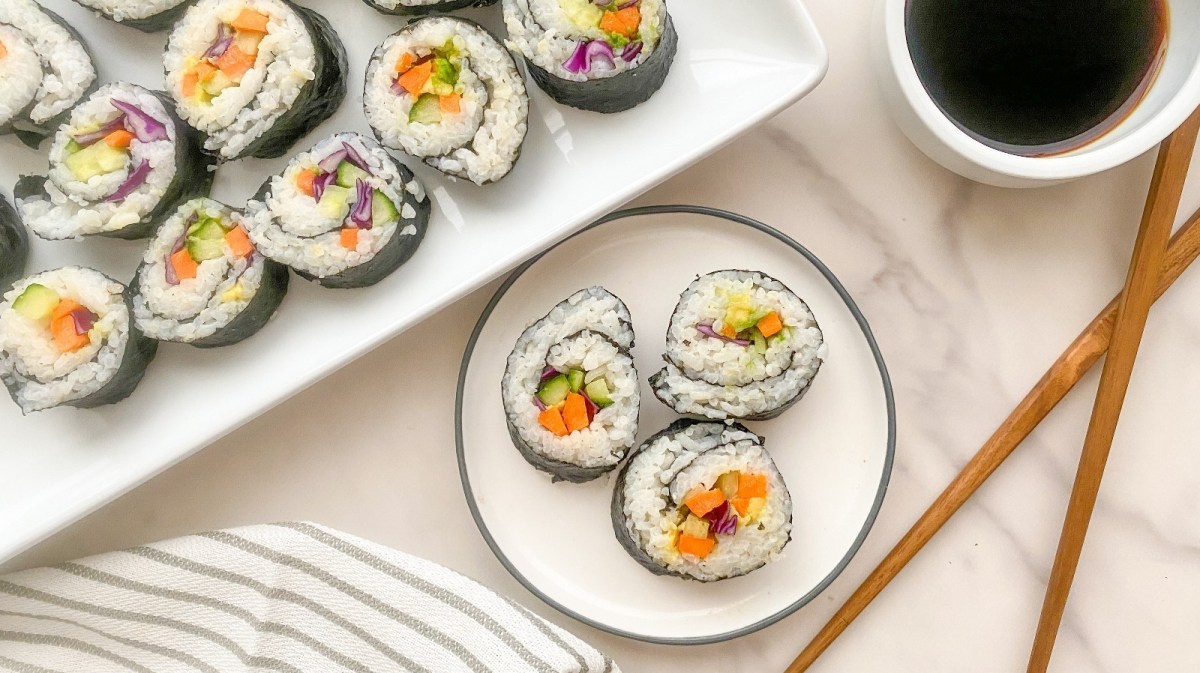Unleash your inner sushi chef and embark on a culinary adventure! This guide unveils the secrets to crafting delicious and healthy flexitarian sushi rolls right in your kitchen. Forget expensive takeout; we’ll journey through ingredient selection, rice preparation techniques, mastering the art of rolling, and finally, achieving stunning presentation. Prepare to be amazed by the vibrant colors, the delightful textures, and the explosion of flavors as you create personalized sushi masterpieces tailored to your taste.
From perfectly seasoned sushi rice to creatively arranged flexitarian fillings—think marinated tofu, vibrant roasted vegetables, and creamy avocado—we’ll cover every step with detailed instructions and inspiring visuals. Learn to expertly roll your creations, whether you prefer the classic inside-out style or the elegant ura-maki. Get ready to impress your friends and family with sushi so good, they’ll never guess it’s homemade!
Ingredient Selection for Flexitarian Sushi Rolls
Crafting delicious and nutritious flexitarian sushi rolls begins with selecting the freshest, highest-quality ingredients. The vibrant flavors and satisfying textures of your creations depend heavily on the quality of your components. This section will guide you through choosing the perfect ingredients to elevate your sushi-making experience.
Common Flexitarian Sushi Ingredients
Choosing ingredients for flexitarian sushi offers a delightful array of options. A well-rounded selection ensures a balanced flavor profile and nutritional value. The following list categorizes common ingredients for easy reference.
- Vegetables: Think beyond the typical avocado and cucumber! Consider vibrant bell peppers (red, yellow, orange) offering a sweet crunch; daikon radish for a peppery bite; carrots for a subtle sweetness; asparagus for a delicate, spring-like flavor; and edamame for a boost of protein and a satisfying pop.
- Tofu: Firm or extra-firm tofu, pressed to remove excess water, provides a neutral canvas for flavorful marinades and sauces. Consider pan-frying or baking it for a firmer texture before incorporating it into your rolls.
- Seaweed (Nori): The foundation of many sushi rolls, nori sheets offer a salty, umami flavor and essential textural contrast. Look for sheets that are dark green and have a glossy sheen, indicating freshness.
- Rice: Sushi rice, short-grain and sticky, is crucial for the proper texture of the roll. Its ability to hold its shape and cling together is essential for a successful roll.
- Other Protein Sources: Beyond tofu, consider incorporating cooked shrimp, baked salmon, or even seasoned tempeh for added protein and flavor.
Nutritional Comparison of Protein Sources
The nutritional profile of your protein source significantly impacts the overall nutritional value of your sushi rolls. The following table compares the nutritional content (per 100g serving) of some common flexitarian sushi protein choices. Note that these values are approximate and can vary based on preparation methods and specific product brands.
| Protein Source | Protein (g) | Fat (g) | Calories |
|---|---|---|---|
| Tofu (firm) | 8 | 4 | 76 |
| Shrimp (cooked) | 20 | 1 | 99 |
| Salmon (baked) | 20 | 13 | 208 |
| Tempeh | 19 | 10 | 190 |
Importance of Fresh, High-Quality Ingredients
Using fresh, high-quality ingredients is paramount for creating exceptional flexitarian sushi rolls. Fresh ingredients deliver superior flavor, texture, and visual appeal. Stale or low-quality ingredients can result in a dull, unappetizing final product. For example, wilted vegetables will lack the vibrant crunch and sweetness that fresh vegetables offer, while dry or discolored nori sheets will negatively impact both the taste and visual appeal of the finished roll. The freshness of the rice is also crucial; properly cooked sushi rice should be slightly sticky but not mushy. Investing in the best ingredients ensures a memorable and delicious sushi experience.
Rice Preparation Techniques

Preparing sushi rice is a crucial step in creating delicious and authentic sushi rolls. The right technique ensures the rice has the perfect texture—slightly sticky but not mushy—essential for holding the ingredients together and providing a pleasing mouthfeel. The type of rice used also significantly impacts the final product.
The choice between short-grain and medium-grain rice is paramount. Short-grain rice, with its rounder, shorter grains, is the preferred choice for sushi due to its higher starch content. This results in a stickier texture, ideal for binding the sushi together. Medium-grain rice, while suitable for other dishes, lacks the necessary stickiness for proper sushi roll formation. Its grains are longer and less prone to clumping, leading to a less cohesive roll.
Short-Grain Rice Rinsing
Before cooking, thoroughly rinsing the short-grain rice is essential. Imagine a bowl filled with pristine white grains, slowly releasing their cloudy starch as you gently swirl them under cool, running water. Continue this process until the water runs almost completely clear, typically taking about 5-7 minutes. This step removes excess starch, preventing the rice from becoming overly sticky and gummy. The visual transformation from murky to crystal-clear water signals the completion of this crucial preparatory stage.
Cooking Short-Grain Rice
Once rinsed, combine the rice with a precise amount of water (usually a 1:1.2 ratio of rice to water, but always check the package instructions). Picture a pot filled with the glistening, rinsed rice, evenly coated with water. Bring this to a rolling boil over high heat, then immediately reduce the heat to the lowest setting, cover tightly with a lid, and simmer for approximately 15 minutes. Resist the urge to lift the lid during this time; the steam is vital for even cooking. After 15 minutes, turn off the heat and let the rice steam, undisturbed, for another 10 minutes. The rice will absorb all the water, creating a perfectly cooked, slightly firm texture.
Seasoning the Cooked Rice
Once the steaming period is complete, gently fluff the rice with a rice paddle or wooden spoon. Avoid using metal utensils, as they can damage the grains. The rice should appear glistening and subtly sticky. Now, add seasoned rice vinegar. The vinegar’s sharp tang cuts through the rice’s sweetness, adding a crucial layer of flavor and preventing the rice from becoming overly sweet. A common ratio is 2 tablespoons of rice vinegar per cup of cooked rice. Other seasonings, such as sugar and salt, can be added to taste, enhancing the flavor profile further. Imagine the gentle folding motion, incorporating the vinegar evenly throughout the fluffy grains, creating a harmonious blend of flavors and textures. The final product should be subtly tangy, glistening, and perfectly sticky, ready for sushi rolling.
Serving and Presentation of Flexitarian Sushi
Elevating your homemade flexitarian sushi from a simple meal to a culinary masterpiece hinges on artful presentation. The visual appeal of your sushi dramatically impacts the dining experience, transforming it from a casual snack into a memorable occasion. Careful attention to plating, color coordination, and accompanying elements can elevate even the simplest rolls.
The key to attractive sushi presentation lies in thoughtful arrangement and the use of contrasting colors and textures. A visually stunning platter invites the diner to engage with the food on a sensory level, enhancing the overall enjoyment. This section explores creative plating techniques and provides a simple recipe for constructing an impressive flexitarian sushi platter.
Creative Plating Ideas
A beautifully arranged sushi platter is more than just a collection of rolls; it’s a work of art. Consider using a large, shallow platter or a bamboo sushi tray as your base. Arrange the rolls strategically, varying their heights and positions to create visual interest. Leave some negative space on the platter to avoid overcrowding. For example, you might place a cluster of vibrant avocado maki in the center, surrounded by a ring of colorful vegetable rolls. Sprinkle toasted sesame seeds or finely chopped chives for added texture and visual appeal. Consider adding a small bowl of pickled ginger and wasabi, artfully placed to complete the composition. Imagine a vibrant green avocado roll nestled next to a bright orange carrot and bell pepper roll, the contrast enhancing the overall visual impact. The clean lines of the rolls themselves can be beautifully offset by the natural curves of a small bowl of soy sauce, perhaps resting on a bed of seaweed.
A Simple Flexitarian Sushi Platter Recipe
This recipe guides you through creating a visually appealing and delicious flexitarian sushi platter, featuring a variety of rolls to cater to different tastes.
Ingredients:
- 1 cup sushi rice, cooked according to package directions
- 2 sheets nori seaweed
- 1 ripe avocado, thinly sliced
- 1/2 cup shredded carrots
- 1/4 cup cucumber, julienned
- 1/4 cup bell pepper (any color), julienned
- 1 tablespoon rice vinegar
- 1 teaspoon sugar
- 1/2 teaspoon salt
- Soy sauce, wasabi, pickled ginger (for serving)
Instructions:
- Prepare the sushi rice: Mix cooked rice with rice vinegar, sugar, and salt. Let it cool.
- Prepare the fillings: Slice the avocado, shred the carrots, and julienne the cucumber and bell pepper.
- Assemble the rolls: Place a sheet of nori on a bamboo sushi rolling mat, shiny side down. Spread a thin layer of rice evenly over the nori, leaving about an inch of space at the top edge.
- Add fillings: Arrange a row of avocado slices, carrots, cucumber, and bell peppers along the center of the rice.
- Roll the sushi: Using the bamboo mat, carefully roll the sushi tightly, tucking in the fillings.
- Slice and serve: Use a sharp, wet knife to slice the rolls into bite-sized pieces. Arrange on a platter with wasabi, pickled ginger, and soy sauce.
Suitable Side Dishes and Accompaniments
Complementary side dishes enhance the overall dining experience. A light and refreshing miso soup adds depth of flavor and provides a comforting contrast to the sushi. Edamame, steamed and lightly salted, offers a satisfying textural element. A vibrant salad with a light vinaigrette, featuring ingredients like seaweed salad or shredded daikon radish, adds a refreshing counterpoint to the richness of the sushi rolls. A small bowl of pickled ginger, a staple in sushi restaurants, cleanses the palate between bites, preparing the taste buds for the next roll. The vibrant green of the edamame contrasts beautifully with the darker tones of the sushi, while the bright colors of the salad provide a visually appealing element to the table setting. Consider the presentation of these sides as carefully as the sushi itself; a small, elegant bowl for the miso soup and attractive serving dishes for the salad and edamame enhance the overall dining aesthetic.
Creating flexitarian sushi rolls at home is more achievable than you might think. With a little practice and the right techniques, you’ll be crafting beautiful, flavorful, and healthy sushi rolls in no time. This journey has equipped you with the knowledge to experiment with various fillings, master the art of rolling, and present your creations with flair. So, gather your ingredients, embrace the process, and enjoy the rewarding experience of making delicious and personalized sushi that reflects your unique culinary style. The possibilities are endless!
FAQ Explained
Can I use brown rice for sushi?
While brown rice is nutritious, it’s not ideal for sushi due to its higher moisture content and tendency to become mushy. Stick to short-grain white rice for the best results.
How long can I store leftover sushi?
Store leftover sushi in an airtight container in the refrigerator for up to 24 hours. The quality may diminish after that time.
What are some good substitutes for nori seaweed?
While nori is traditional, you can experiment with rice paper wrappers or even large lettuce leaves for a unique twist.
What if my sushi rice is too sticky or too dry?
Too sticky? Add a little more rice vinegar. Too dry? Add a tiny bit of water and gently mix.


